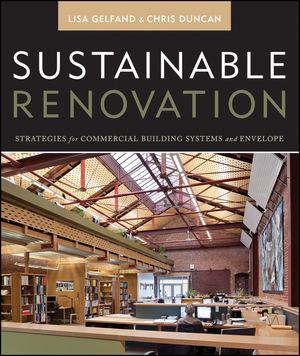
Marion Smith is the president of Engine House No. 1 Inc. in St. Louis. (Photos courtesy of Engine House No.1 Inc.)
Marion Smith came of age during the Sputnik era when math and science were king. Now after 14 years as president of Engine House No. 1 Inc. in St. Louis, Smith’s historical journey is just heating up.
“As a liberal arts student, I couldn’t decide whether to be a math or English major,” Smith told Architectural Roofing & Waterproofing. “While getting career counseling at the University of Michigan, I traveled with a friend and his father, who was an architect. His father was so passionate about architecture and talked about the technical portion of architecture as the underwater invisible part of the iceberg. I thought I would like this and could do it. But it meant starting college over because I had none of the prerequisites.”
Smith stayed out of school and worked in an architectural office for a year to make sure she liked it and to save money before starting architectural studies at McGill University in Montreal.

Shown is a before photo of the St. Charles (Mo.) Tobacco Plantation House.
Transferring to the Rhode Island School of Design after her third year of college gave Smith the freedom she was looking for.
“I eventually developed skills in master planning, space programming and feasibility studies that allowed me to be involved in major decisions about facilities long before any design of the building was started,” Smith said. “In working my way through school, I would enroll for a couple of years, and then work in an architectural office, gaining valuable experience that complemented my education.”

Shown is an after photo of the St. Charles (Mo.) Tobacco Plantation House.
From America to England
Smith worked one year in England drawing with ink on vellum. “The floor of the 17th century Windsor market/town hall was so uneven if you dropped an eraser at one corner you picked it up at the opposite one,” she said. “The patients of the Victorian ‘Lunatic Asylum’ thought this young woman measuring windows was crazier than they. I also did research on reed-thatched roofs on a bicycle/hostel trip through East Anglia for my summer research paper for McGill.”After a decade of working her way through school and finally getting a degree, Smith spent 8 years in a city she grew to love: Boston.

This cut-away rendering shows the design for the Enrollment Center at Lincoln University. (Images courtesy of Engine House No. 1 Inc.)
Smith’s search for a building that would give her artist husband, Steve, a studio as well as a home for the two of them eventually brought Smith to St. Louis (her husband’s hometown) to renovate the first fire station owned and operated by the city.
“Over the years it has proved very flexible, accommodating my mother, a stroke survivor in a wheelchair, and eventually the old sleeping quarters housing my office,” Smith noted. “I continued working in higher education and on older buildings but also developed experience in the design of animal facilities from work for the veterinary, agriculture, biology departments, including acoustic chambers for bats and frogs.”
As a graduate during the oil crisis of the 1970s, Smith has always been interested in energy conservation and sustainability. “I had the opportunity to work on a sustainable building before the LEED certification process was started,” said Smith, who noted she was a founder of the AIA-St. Louis Chapter of the Committee on the Environment and the U.S. Green Building Council, St. Louis Regional Chapter.

A skylight shows the light in the Enrollment Center at Lincoln University in Jefferson City, Mo.
Types of Architectural Work
As a small firm of “two and a half employees,” Smith’s projects are typically smaller and frequently revolve around the renovation of older buildings.“We focus on institutional/governmental projects in our specialty areas of higher education, historic buildings and animal facilities,” Smith said. “Much of our university work is on historic buildings on older campuses, but we also do preservation work on state and local historic sites where the building itself is the museum and tells the story.”
Smith said the firm’s animal-related work has blossomed into not only veterinary clinics/hospitals and shelters but also wildlife rehabilitation centers.
“I never thought we would be able to combine our animal and historic work but we renovated the Flight Cage at the St. Louis Zoo for the centennial of the 1904 World’s Fair,” she said. “We are frequently added to larger design teams on larger projects as a consultant, often as the historic architect, to restore the exterior of an older building or to design the exterior of a new building that must harmonize in a campus of older buildings.
“Because our projects are smaller, they often don’t have the budget or time to pursue LEED certification, but many are designed to meet those certification requirements and most incorporate sustainable elements.”

This photo shows a stairwell at the Enrollment Center at Lincoln University.
Recent Projects
Smith’s firm recently worked on the stabilization of the Bauvais-Amoureux House, a rare 18th century poteaux-en-terre (“post in the ground”) French colonial house in Ste. Genevieve, Mo., a historic site recently acquired by the State of Missouri, Department of Natural Resources, Division of State Parks.“Because the structure had been altered many times over the centuries and no period of significance had been identified yet for interpretation, all work focused on the stabilization and investigation of the building,” Smith said “We replaced the existing seamed metal roof with wood shingles treated with fire retardant applied directly onto the wood strapping without building paper. This allowed the shingles to breathe from both sides and helps in drying out the shingles.”
Smith said there is evidence that the original roof was thatch but when the porches were added along the long sides of the building, which protected the posts in the ground from rotting, the slopes of the porches were too shallow for thatch.
“The DNR wanted to allow visitors to see the beautiful Norman trusses in the attic so the nails used on the roof were square-headed steel cut,” Smith said. “In cases where the underside of the roof is not part of the interpretation, we used galvanized or stainless steel nails for durability. We also replaced the wood siding with new clear cedar, vertical grain, quarter-sawn.”
“This is a custom order and we had to wait for three months for the loggers strike in California to settle to get our siding,” she continued. “But it was worth the wait.”
Ironically, historic buildings were often designed sustainably, noted Smith. “Because the original buildings and occupants did not have lots of energy to throw at their structures, they used native materials and were smart about orienting the building to take advantage of sun and wind,” she said. “To find materials that replicate what was originally used, we are taking wood from first growth Canadian forests. Cedar depletes the minerals in the soil and the second growth is scrubby and makes poor construction materials. Finding sources for replicating the old materials can be challenging, and we oftentimes identify sources on our bid documents to help the contractors and keep speculative pricing out of the equation.”

Marion Smith’s firm recently worked on the stabilization of the Bauvais-Amoureux House, a rare 18th century French colonial house in Ste. Genevieve, Mo., a historic site recently acquired by the State of Missouri, Department of Natural Resources, Division of State Parks.
Challenges of Historic Sites
Discovery on public projects is always a challenge, Smith said.“Since public projects need to be publicly bid, all the research and discovery must be done months before the contractor is on board and the scope of work defined and details developed without the benefit of exploration behind the existing surfaces,” she said. “Although we crawl into attics, onto roofs, into crawl spaces and hanging off lifts, that’s only half the story. Sometimes during the demolition phase, something will get uncovered that changes our restoration strategy and we have to make changes.
“Where we know there are questions about the extent of work of a particular item, we will specify a specific quantity of work to be done and ask the bidders to give a unit price to adjust the contract amount up or down when the full extent of the work is known.”
During the discovery on the reconstruction of an 1840s tobacco plantation house for St. Charles County Department of Parks and Recreation, Smith said her firm was fortunate that the demolition and deconstruction contract for the house ravaged by fire was let early.
“We spent many hours at the site while the demo crew was working, asking the crew to salvage a second floor mantel or a remaining cornice bracket so we could detail the reconstruction of the house,” Smith noted. “We are constantly trying to balance the historic interpretation needs with practical considerations for protecting and maintaining these old structures.”
For example, where the building is a museum and the element is visible, Smith’s firm tries to use authentic materials, such as wood shingles or slate roofing. “Where the element is not part of the interpretation or not visible, we will select contemporary materials that are durable and cost effective,” she said. “On flat roofs, we will use a variety of membranes and occasionally create a green roof, as we did at the St. Louis Zoo Flight Cage to camouflage the back-of-house support structure and continue the exhibit over the roof. In historic buildings still in use, we may use an architectural asphalt shingle that simulates the original wood shingle or slate tile.”

Marion Smith goes over a design with husband Steve.
Design Story
Lincoln University in Jefferson City, Mo., wanted to consolidate all their enrollment services in one location in their administration building, Young Hall, one of the oldest buildings on campus. As the campus had grown and new buildings were constructed, functions were pulled out allowing the administration to grow in a patchwork quilt manner.“We started by defining their program requirements for the enrollment center and did a feasibility study to show options for locating the center,” Smith said. “The building was a four-story U-shaped building with the original gymnasium on the lower floor nested into the courtyard. It had long since been filled with a second floor and converted to offices. One of the schemes we developed took the old gymnasium space for the enrollment center, forming an atrium in the middle with a circular staircase and skylight in the center and located all the offices around the atrium on both floors. The atrium provides benches for students and families to wait, have informal talks, check out classes online, and the offices have storefronts over looking this public space. We liked this scheme but weren’t expecting the client to select it. Fortunately their leadership had vision, accepted it and, over 10 years later, it is still a signature space on campus.”
Smith’s firm may be small, but it brings a number of skills to the table. “We can work on the big picture, master planning, space programming, site selection, feasibility studies, and still perform the traditional architectural services of design, construction documents and construction administration,” she said. “We also provide continuity and accountability. The project does not get passed from designer to project architect to construction administrator. There is no question of who is responsible and, if something goes wrong, that person steps up to the plate and fixes it.”
Smith pointed out that in the “M.A.S.H.” television series, Charles Winchester might have been a super-skilled surgeon, but Colonel Potter would want Hawkeye Pierce to work on him because he would bust his gut for his patient. “I like to think of us as the Hawkeye,” she said. “We have many repeat clients because we go the extra mile for them and we get referrals.”

Marion Smith’s firm renovated the Flight Cage at the St. Louis Zoo for the centennial of the 1904 World’s Fair. (Photo courtesy of Debbie Franke)
Future Expectations
After years working in larger firms and finding her self managing other people more and more rather than doing architecture, Smith finds it refreshing to roll up her sleeves and be intimately involved in all aspects of the project.“Working for myself gives me flexibility to establish life priorities, and I am happy to say that I am able to give my other employees the same flexibility,” Smith concluded. “I am not interested in growing the firm, but I am hopeful that one of my employees will want to take on more firm management responsibilities and eventually head the firm as I slow down with age. I will probably be one of those architects who never fully retire. Did I say I love my work?”
For more information on Engine House No. 1 Inc., 2411 McNair Ave., St. Louis, MO 63104, call 314-772-7700.





